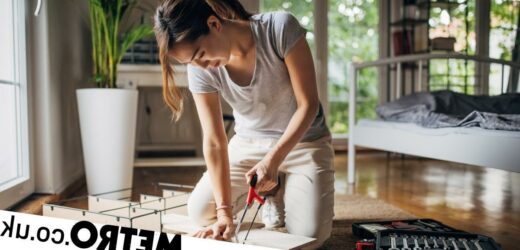In the age of the do-it-yourself movement people are constantly renovating and re-designing their homes in an attempt to add value to them.
After all, no-one wants to sell their property for less than they bought it for because of their questionable design choices, like this property in Droylsden.
But what we think potential buyers will like isn’t necessarily the case, and the property development experts at Essential Living have dished on the ‘home improvement’ projects which could actually devalue your pad.
There are also projects which may fail to add value, meaning you’re essentially flushing money down the toilet.
So, to ensure no money is wasted in the process, here are seven common ‘home improvements’ to avoid.
Installing a new kitchen
For most people, the kitchen is the heart of the home, but fitting a brand spanking new kitchen isn’t necessarily a sensible financial decision.
First, know that the next tenant or homeowner may not actually like the new design you choose – especially if it involves bold colours or a trending style.
Instead, they may take one look and plan to redo it all over again as soon as they move in.
Alternatively, it’s a lot safer (and cheaper) to refresh the space with a lick of paint.
Also, when it comes to fitting high-end appliances in the kitchen, they can cost double the amount of average appliances with a similar purpose.
Covering up the property’s original character
Covering up or replacing the original character of your property in an attempt to create a more modern look can often decrease its value.
Instead, investing money to maintain or restore the original characteristics of the home is more likely to attract interest.
Built in electronics
Personalisation is likely to deter would-be renters or home-buyers.
It’s easy to be persuaded by the idea of a built-in sound system or home cinema, but the reality is, most people will prioritise the more functional aspects of the property first.
With home cinemas, the average cost of installing one is priced at £27,500 and adds only £2,000 onto the overall value of the property, which is a significant loss.
Transforming a bedroom into a wardrobe
Removing bedrooms is never a smart decision. In fact, people are more likely to appreciate a spare room or another space to utilise for an office instead of the perks of a walk-in wardrobe.
Yes, a walk-in wardrobe is an incredible feature to have if there’s space for it, but not at the expense of an additional bedroom.
Fitting expensive wallpaper
Wallpaper can vary significantly in price depending on style and design.
Hanging up some new wallpaper can be very tempting as a quick fix to spruce up a room, but similar to fitting a new kitchen, the success of this all comes down to taste.
People are now experts at viewing a property and making note of all the redecoration ideas they have, so splashing out on new wallpaper may be a wasted effort.
Getting rid of the bath
A common bathroom mistake is removing the bath. While it is more expensive to run a bath versus a shower and shower-only bathrooms make sense in terms of utilising the space, not having the option of a bath can put people off the property altogether.
Installing a wine cellar
Only true wine connoisseurs with an extensive collection of high-quality wines will truly reap the rewards of a wine cellar in their home.
The cost of fitting one can easily hit the £70,000 mark, and while it may seem like a unique selling point, relying on a buyer who can match this love of wine is a big risk to take.
As a general rule to follow when it comes to home improvements and repairs, investing in the basic foundations of the home, like heating systems, the roof, electric and water services, are most likely to boost its value, whereas cosmetic tweaks are less likely to have the same effect.
Do you have a story to share?
Get in touch by emailing [email protected].
Source: Read Full Article




